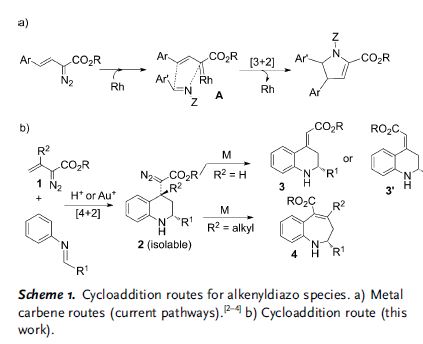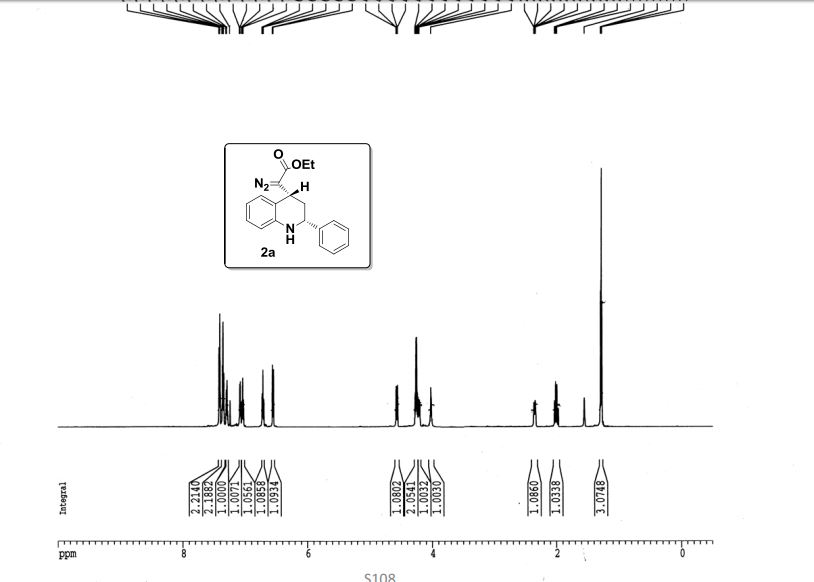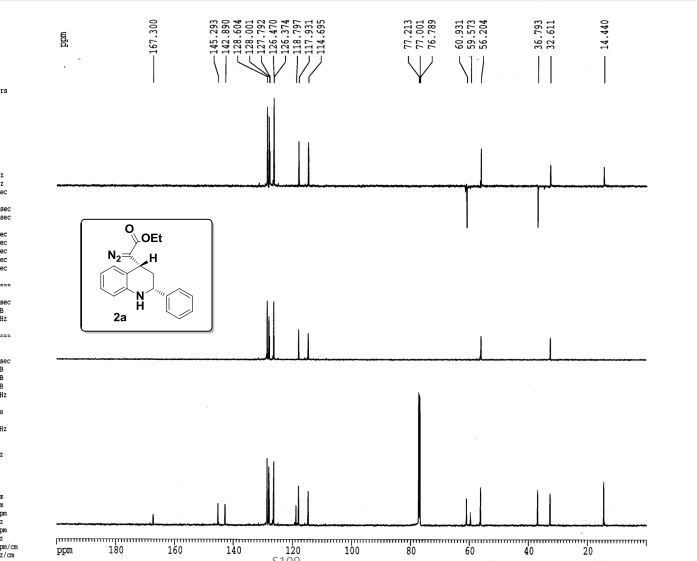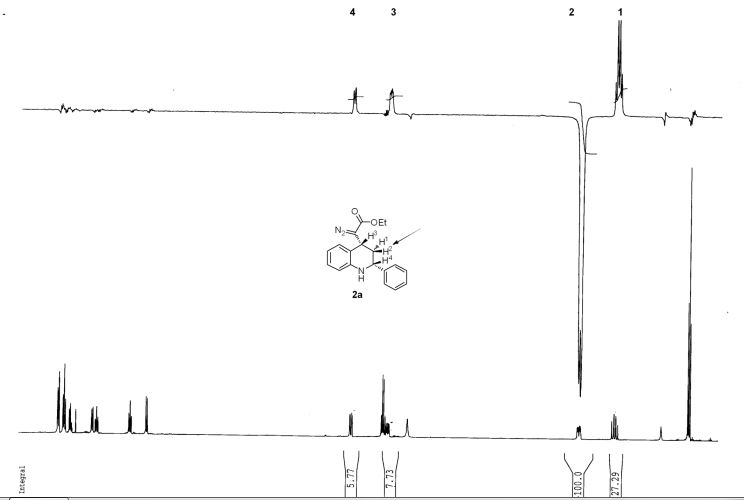

Discussing my paper........
Metal-catalyzed cycloadditions of alkenyldiazo reagents are useful tools to access carbo- and heterocycles.[1] These diazo compounds are chemically sensitive toward both Brønsted orLewis acids. Their reported cycloadditions rely heavily on the formation of metal carbenes to initiate regio- and stereoselective [3+n] cycloadditions (n=2–4) with suitable dipolarophiles.[2–4] A noncarbene route was postulated for a few copper-catalyzed cycloadditions of these diazo species, but they resulted in complete diazo decomposition.[3a, 4a, 5] oyle and co-workers reported[4a] a [3+2] cycloaddition of the alkenylrhodium carbene A with imines to give dihydropyrroles (Scheme 1a). We proposed a cycloaddition the tetrahydroquinoline derivatives 3 and 3’, as well as the tetrahydro-1H-benzo[b]azepine species 4. Access to these frameworks are valuable
Access to these frameworks are valuable for the preparation of several bioactive molecules including 2-phenyl-2,3-
dihydroquinolone,[8a] L-689,560,[8b] torcetrapib,[8c] martinellic acid,[8d] OPC-31260,[8e] OPC-51803,[8f] and tetraperalone A (Figure 1).[8g] Their specific biological functions have been well documented.[8]
dihydroquinolone,[8a] L-689,560,[8b] torcetrapib,[8c] martinellic acid,[8d] OPC-31260,[8e] OPC-51803,[8f] and tetraperalone A (Figure 1).[8g] Their specific biological functions have been well documented.[8]
Spectral data for ethyl 2-diazo-2-(2-phenyl-1,2,3,4-tetrahydroquinolin-4-yl) acetate (2a)
Yellow Semi-Solid;
IR (KBr, cm-1 ): 3542 (m), 2117 (s), 3015 (s), 1737 (s), 1564 (s), 1334 (m), 1137 (s), 817 (s);
1H NMR (600 MHz, CDCl3): δ 7.41 (d, J = 7.3 Hz, 2 H), 7.36 ~ 7.33 (m, 2 H), 7.30 (t, J = 7.3 Hz, 2 H), 7.07 (d, J = 7.6 Hz, 1 H), 7.04 (t, J = 7.6 Hz, 1H), 6.71 (t, J = 7.2 Hz, 1H), 6.55 (d, J = 7.9 Hz, 1H) 4.56 (dd, J = 11.0, 2.3 Hz, 1H ), 4.25 (q, J = 7.1 Hz, 2H ), 4.21 (dd, J = 11.0, 5.3 Hz, 1H ), 4.01 (s, 1H) 2.36 ~ 2.33 (m, 1H), 2.00 (dd, J = 11.8, 2.3 Hz, 1H ), 1.28 (t, J = 7.1 Hz, 3H);
13C NMR (150 MHz, CDCl3): δ 167.2, 145.3, 142.9, 128.6, 128.0, 127.8, 126.5, 126.4, 118.8, 117.9, 114.4, 60.9, 59.5, 56.2, 36.8, 32.6, 14.4.
HRMS calcd for C19H19N3O2: 321.1477; found: 321.1483.





Communication
Development of a Povarov Reaction/Carbene Generation Sequence for Alkenyldiazocarbonyl Compounds†
Authors, Appaso Mahadev Jadhav, Vinayak Vishnu Pagar, and Rai-Shung Liu*,
Development of a Povarov Reaction/Carbene Generation Sequence for Alkenyldiazocarbonyl Compounds†
Authors, Appaso Mahadev Jadhav, Vinayak Vishnu Pagar, and Rai-Shung Liu*,
Department of Chemistry, National Tsing Hua University
Hsinchu (30013) (Taiwan)
E-mail: rsliu@mx.nthu.edu.tw
Hsinchu (30013) (Taiwan)
E-mail: rsliu@mx.nthu.edu.tw
Abstract

[1] Selected reviews: a) M. P. Doyle,M. A. McKervy, T. Ye, Modern Catalytic Methods for Organic Synthesis with Diazo Compounds, Wiley, New York, 1998; b) A. Padwa, M. D. Weingarten, Chem. Rev. 1996, 96, 223; c) H. M. L. Davies, J. R. Denton, Chem. Soc. Rev. 2009, 38, 3061; d) M. P. Doyle, R. Duffy, M. Ratnikov, L. Zhou, Chem. Rev. 2010, 110, 704; e) H. M. L. Davies, D. Morton, Chem. Soc. Rev. 2011, 40, 1857; f) Z. Zhang, J. Wang, Tetrahedron
2008, 64, 6577.
[2] Selected examples for carbocyclic cycloadducts, see: a) L. Deng, A. J. Giessert, O. O. Gerlitz, X. Dai, S. T. Diver, H. M. L. Davies, J. Am. Chem. Soc. 2005, 127, 1342; b) H. M. L. Davies, Adv. Cycloaddit. 1999, 5, 119; c) H. M. L. Davies, B. Xing, N. Kong, D. G. Stafford, J. Am. Chem. Soc. 2001, 123, 7461; d) H. M. L. Davies, T. J. Clark, H. D. Smith, J. Org. Chem. 1991, 56, 3819; e) Y. Liu, K. Bakshi, P. Zavalij, M. P. Doyle, Org. Lett. 2010, 12, 4304; f) J. P. Olson, H. M. L. Davies, Org. Lett. 2008, 10, 573.
[3] For oxacyclic cycloadducts, see: a) X. Xu, W.-H. Hu, P. Y. Zavalij, M. P. Doyle, Angew. Chem. 2011, 123, 11348; Angew. Chem. Int. Ed. 2011, 50, 11152; b) M. P. Doyle, W. Hu, D. J. Timmons, Org. Lett. 2001, 3, 3741.
[4] For azacyclic cycloadducts, see selected reviews: a) M. P. Doyle, M. Yan, W. Hu, L. Gronenberg, J. Am. Chem. Soc. 2003, 125, 4692; b) J. Barluenga, G. Lonzi, L. Riesgo, L. A. L pez, M. Tomas, J. Am. Chem. Soc. 2010, 132, 13200; c) M. Yan, N. Jacobsen, W. Hu, L. S. Gronenberg, M. P. Doyle, J. T. Colyer, D. Bykowski, Angew. Chem. 2004, 116, 6881; Angew. Chem. Int. Ed. 2004, 43, 6713; d) X.Wang, X. Xu, P. Zavalij, M. P. Doyle, J. Am.
Chem. Soc. 2011, 133, 16402; e) Y. Lian, H. M. L. Davies, J. Am. Chem. Soc. 2010, 132, 440; f) X. Xu, M. O. Ratnikov, P. Y. Zavalij, M. P. Doyle, Org. Lett. 2011, 13, 6122; g) V. V. Pagar, A. M. Jadhav, R.-S. Liu, J. Am. Chem. Soc. 2011, 133, 20728; h) R. P. Reddy, H. M. L. Davies, J. Am. Chem. Soc. 2007, 129, 10312.
[5] Y. Qian, X. Xu, X.Wang, P. Zavalij,W. Hu, M. P. Doyle, Angew. Chem. 2012, 124, 6002; Angew. Chem. Int. Ed. 2012, 51, 5900.
[6] Povarov reactions refer to the formal [4+2] cycloadditions of Naryl imines with enol ethers or enamines. See reviews: a) L. S. Povarov, Russ. Chem. Rev. 1967, 36, 656; b) V. V. Kouznetsov, Tetrahedron 2009, 65, 2721; c) D. Bello, R. Ram n, R. Lavilla, Curr. Org. Chem. 2010, 14, 332; d) M. A. McCarrick, Y. D. Wu, K. N. Houk, J. Org. Chem. 1993, 58, 3330; e) A. Whiting, C. M. Windsor, Tetrahedron 1998, 54, 6035.
[7] For Povarov reactions catalyzed by Brønsted acids, see selected examples: a) H. Xu, S. J. Zuend, M. G. Woll, Y. Tao, E. N. Jacobson, Science 2010, 327, 986; b) T. Akiyama, H. Morita, K. Fuchibe, J. Am. Chem. Soc. 2006, 128, 13070; c) H. Liu, G. Dagousset, G. Masson, P. Retailleau, J. Zhu, J. Am. Chem. Soc. 2009, 131, 4598; d) G. Dagousset, J. Zhu, G. Masson, J. Am. Chem. Soc. 2011, 133, 14804; e) H. Ishitani, S. Kobayashi, Tetrahedron Lett. 1996, 37, 7357; f) G. Bergonzini, L. Gramigna, A. Mazzanti, M. Fochi, L. Bernardi, A. Ricci, Chem. Commun.
2010, 46, 327; g) L. He, M. Bekkaye, P. Retailleau, G. Masson, Org. Lett. 2012, 14, 3158.
[8] a) Y. Xia, Z.-Y. Yang, P. Xia, K. F. Bastow, Y. Tachibana, S.-C. Kuo, E. Hamel, T. Hackl, K.-H. Lee, J. Med. Chem. 1998, 41, 1155; b) R.W. Carling, P. D. Leeson, A. M. Moseley, J. D. Smith, K. Saywell, M. D. Trickelbank, J. A. Kemp, G. R. Marshall, A. C. Foster, S. Grimwood, Bioorg. Med. Chem. Lett. 1993, 3, 65;
c) D. B. Damon, R. W. Dugger, R.W. Scott, U.S. Patent 6,689,897, 2004; d) D. A. Powell, R. A. Batey, Org. Lett. 2002, 4, 2913; e) A. Matsuhisa, K. Kikuchi, K. Sakamoto, T. Yatsu, A. Tanaka, Chem. Pharm. Bull. 1999, 47, 329; f) M. Y. Christopher, E. A. Christine, D. M. Ashworth, J. Barnett, A. J. Baxter, J. D. Broadbridge, R. J. Franklin, S. L. Hampton, P. Hudson, J. A. Horton, P. D. Jenkins, A. M. Penson, G. R.W. Pitt, P. Rivi re,
P. A. Robson, D. P. Rooker, G. Semple, A. Sheppard, R. M.Haigh, M. B. Roe, J. Med. Chem. 2008, 51, 8124; g) C. Li, X. Li, R. Hong, Org. Lett. 2009, 11, 4036.
About author( Me)

Dr. Vinayak Pagar
Postdoctoral Research Fellow at The Ohio State University
Vinayak Vishnu Pagar was born in Nasik, Maharashtra (India) in 1983. He obtained his BSc and MSc degrees in chemistry from the University of Pune (India) in 2004 and 2006, respectively. From 2006–2010, he worked as Research Associate in pharmaceutical companies like Jubilant Chemsys Ltd. and Ranbaxy Laboratories Ltd. (India). In 2010, he joined the group of Professor Rai-Shung Liu to pursue his PhD degree in National Tsing Hua University (Taiwan) and completed it in 2014. Subsequently, he worked as a postdoctoral fellow in the same group for one year. Currently, he is working as a Research Scientist at The Ohio State University, Columbus, Ohio USA. His research focused on the development of new organic reactions by using transition-metal catalysis such Gold, Silver, Rhodium, Zinc, Cobalt, Nickel and Copper metals which enables mild, diastereoselective, enantioselective and efficient transformations of variety of readily available substrates to wide range of synthetically useful nitrogen and oxygen containing heterocyclic products which are medicinally important. He published his research in a very high impact factor international Journals includes J. Am. Chem. Soc., Angew. Chem. Int. Ed., J. Org. Chem., Chem- A. Eur. Journal, Org. Biomol. Chem., and Synform (Literature Coverage).
Dr. Vinayak Pagar
Postdoctoral Researcher
Department of Chemistry and Biochemistry
The Ohio State University
100 West 18th Avenue
Columbus, Ohio 43210 USA
/////////Vinayak Pagar, Postdoctoral Research Fellow, The Ohio State University, blog, Povarov Reaction, Carbene Generation Sequence, Alkenyldiazocarbonyl Compounds

1521-3773/asset/olalertbanner.jpg?v=1&s=0c0a7bae38bad177497650f0bc0083504684f4fa)